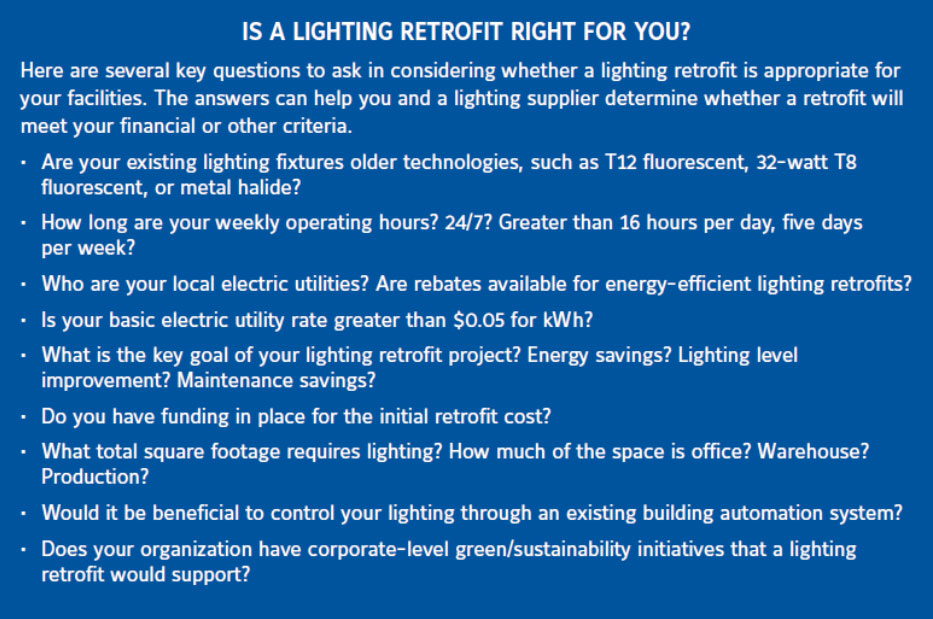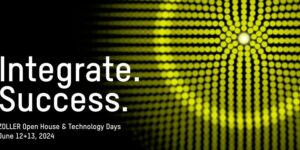INDUSTRIAL LIGHTING: THE PRACTICAL SIDE OF GREEN MANUFACTURING
Let There Be Light: Guest columnist Reginald Cook of Johnson Controls explores how advancing technology, rebate incentives, and sustainability imperatives argue strongly for complete industrial lighting retrofits.
Posted: December 29, 2011
Warehouses with skylights can make use of daylight harvesting: Dimming ballasts are installed and fixture-mounted photocell sensors are set so that lamps turn down or off when daylight provides enough illumination. For optimum control, daylight harvesting can be used with occupancy sensors and with lighting control panels or facility management systems. In some facilities, interest in controls is also moving to large production spaces. Here, occupancy sensors automatically dim lights or turn off a specified percentage of fixtures during weekends or on the third shift when the facility is occupied sparsely or not at all and equipment is not operating.
LOOKING OUTDOORS
Outdoor spaces provide more savings opportunities. In parking garages, fluorescent fixtures with vapor-tight enclosures and drop lenses that distribute light can economically replace the less efficient high pressure sodium units typically used. Occupancy sensing controls with dimmable ballasts can add to savings, and daylight harvesting can be used in open sided structures. Payback takes longer in open space parking lots because lights burn only about half the time on average, but controls that dim lights during low activity night hours save electricity.
Part of a complete lighting upgrade is an analysis report that includes before and after foot-candle measurements in all key areas and before and after photographs that show the differences in lighting level, distribution, and color rendering.
IMMEDIATE REWARDS
Beyond utility bill savings, government and utility incentives accelerate payback on lighting upgrades. Investor owned and public utilities in many states offer rebates, some of which may cover up to 20 or 30 percent of a project’s initial project cost. Rebate programs are like snowflakes: No two are the same. Some offer a flat amount per fixture, others an amount based on the kilowatt-hour reduction. Amounts vary greatly, and application procedures, pre- and post-project inspections, and other requirements also differ.
A comprehensive lighting upgrade can include turnkey rebate management by the lighting supplier – especially helpful for corporate level upgrades in businesses with locations in many states and utility territories. Another popular lighting upgrade incentive is the Energy Efficient Commercial Buildings Tax Deduction created by the Energy Policy Act of 2005 (EPACT) and in effect through 2013. It cuts the initial cost of investing in energy efficient lighting through an accelerated tax deduction: Building owners can write off the full cost of an indoor lighting upgrade in the first year instead of depreciating it over several years. In addition, section 179D of the act allows for a tax deduction of up to $0.60 per square foot for lighting retrofits that meet certain energy usage reduction criteria that are often very attainable.
TOWARD THE FUTURE
The lighting industry is on the cusp of major change as new technologies emerge and become commercialized. Full service, technology-neutral lighting suppliers can provide advice on these technologies without bias on when and where to deploy them cost effectively, and help evaluate them through pilot testing.
One technology gaining acceptance quickly is LED lighting – already widely used in traffic lights. LEDs are extremely energy efficient, long lasting and a high quality light source. At present, high initial cost rules it out for large spaces, but manufacturers are steadily improving both cost and efficacy. A concept known as Haitz’s law (analogous to Moore’s law dealing with the increasing power and decreasing cost of computer chips), says that:
- Every decade, output per LED package increases by a factor of 20.
- Every decade, cost per lumen from LED light decreases by a factor of 10.
One estimate showed that if LEDs made up 45 percent of the lighting supply by 2020, the world would eliminate 5 trillion kWh of electricity, 559 full sized power plants, and 8.4 billion tons of carbon emissions.5
Some industry observers have projected that by 2018, some 70 percent of all lamps and fixtures sold will be LEDs. For now, good LED applications in industrial settings include parking garages and exterior lighting for parking lots and other locations where light pollution is an issue. LED light is highly directional and can easily be aimed downward or “cut off” at a property line. Other promising lighting technologies in the wings include:
Light Emitting Plasma (LEP). The makers of this technology promote energy savings of 50 percent or more over metal halide lighting with low maintenance, long lamp life, and full-spectrum white light that mimics sunlight. This technology is designed for applications that include large industrial spaces and areas that require high light levels. The lamps are dimmable with analog or digital control.
Direct-drive light engine. The manufacturer says this technology is retrofittable to existing fixtures, operates with many commercially available lamps, and is well suited to industrial spaces. It substantially changes the way the ballast is driven to produce high lumens per watt, high lumen maintenance, longer lamp life, quality color rendering, and capability for continuous dimming, motion sensing, scheduling and daylight harvesting.
TIME FOR DECISION
A generous window of opportunity exists today for industrial lighting retrofits. Market forces, sustainability imperatives, and government utility incentives are all aligned to encourage conversion to more efficient lighting. Such projects also deliver “soft” benefits that include enhanced safety, greater work productivity and quality, and improved morale.
A turnkey lighting retrofit is an extremely low risk, fast return, high reward venture that is largely effortless and delivers documented results. Every month and year spent with inefficient lighting means substantial loss of energy and loss of dollars that could be invested more productively.
CASES IN POINT: MANY SITES, MULTIPLE YEARS
A global leader in producing pulp, tissue, paper, packaging and building products saved $3.5 million annually on energy and maintenance through a multi-year lighting upgrade program that began in 2006 and covered 38 industrial sites with a combined 16.4 million sq ft. The turnkey project, an $8.5 million capital investment, included a needs assessment, lighting audits and analysis, and warranty and rebate management. The project saved 52 million kWh and 37,000 tons of carbon dioxide emissions annually.

One Fortune 500 electrical components manufacturer updated lighting in production, warehouse and office spaces totaling 140,000 sq ft, achieving 60 percent lighting level improvement, 48 percent energy savings, 533 metric tons of carbon dioxide emission reduction and 71 percent ROI. The project replaced 400 W metal halide high-bay lighting in the production and warehouse spaces with 6-lamp T8 fluorescent fixtures and replaced older T12 fluorescent fixtures in office areas with T8 lamp and electronic ballast technology. The work also included strategically placed occupancy sensors.
The maintenance division of an international air carrier contracted for a lighting upgrade in two hangars to help productivity, employee well being, and the environment. The project saved more than $180,000 annually on energy, reduced carbon dioxide emissions by 1,809 metric tons per year, and increased light levels by almost 40 percent.

The hangars, operating around the clock, cover 63 acres, or 2.7 million sq ft. An investment grade audit identified places to save energy and money. The 10-week project replaced 317 metal halide fixtures in one hangar with 6-lamp T5 fluorescent fixtures, reducing system wattage from 420 W to 351 W while increasing light levels from 24 to 36 foot-candles and improving the color rendering index from 65 to 85. In the second hangar, 694 high pressure sodium fixtures were replaced with 347 8-lamp T5 fluorescent fixtures, reducing system wattage from 930 W to 452 W.
An international provider of printing and related services embarked on a lighting upgrade program to save energy, cut maintenance costs, and improve lighting quality to enhance print production process quality. Starting in 2005, the company invested more than $10 million to upgrade lighting in 58 sites representing 14.4 million sq ft. Annual energy and maintenance savings have totaled $5 million, reducing electricity consumption by 84 million kWh and saving 44,000 tons of carbon dioxide emissions.
Resources
1 http://www.undp.org.cn/projects/00062179.pdf
2 Energy Efficient Lighting for Commercial Markets: LED Solid State Lighting and Other High Efficiency Lighting Technologies for Commercial, Industrial, and Outdoor Stationary Applications. PikeResearch, 2010.
3 Energy Efficient Lighting for Commercial Markets: LED Solid State Lighting and Other High Efficiency Lighting Technologies for Commercial, Industrial, and Outdoor Stationary Applications. PikeResearch, 2010.
4 Energy Advisor, LD+A, May 2011, Illuminating Engineering Society.
5 Based on United States Energy Information Administration estimates.
Reginald D. Cook is the vice president and general manager for lighting services at Johnson Controls, Inc., P. O. Box 423, Milwaukee, WI 53201, www.johnsoncontrols.com.










